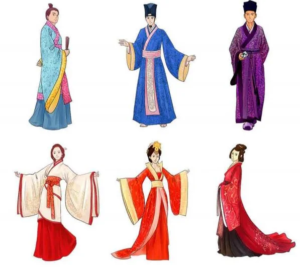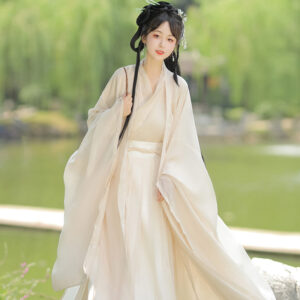

The Tang suit and Hanfu are both integral parts of Chinese cultural attire, but they have distinct origins, designs, and cultural significances. Here’s a detailed comparison highlighting their differences:
1. Historical Background
- Hanfu:
- Originates from the Han Dynasty (206 BCE – 220 CE) and represents the traditional clothing of the Han Chinese. It has evolved over more than 3,000 years, reflecting various dynasties’ styles and cultural values.
- Tang Suit:
- Despite its name, the Tang suit (or Tangzhuang) is a modern adaptation that emerged during the late Qing Dynasty (1644-1912). It reflects a blend of Manchu influences and Western dress norms that became prominent in the 19th and 20th centuries.
2. Design and Structure
- Hanfu:
- Characterized by flowing robes with wide sleeves, a cross-collar design, and layered garments. The right side typically wraps over the left, secured with a sash. Hanfu emphasizes elegance and grace.
- Tang Suit:
- Features a straight collar (Mandarin collar) and button closures down the front, often adorned with frog buttons. The design is more structured and fitted compared to the loose silhouette of Hanfu.
3. Cultural Significance
- Hanfu:
- Represents ancient Chinese civilization and cultural heritage. It is often worn during traditional ceremonies, weddings, and festivals, symbolizing a connection to history and tradition.
- Tang Suit:
- While also culturally significant, the Tang suit symbolizes modern Chinese identity and adaptability. It is commonly worn during formal occasions like diplomatic meetings and festive celebrations.
4. Fabrics Used
- Hanfu:
- Traditionally made from silk, hemp, cotton, or ramie. The choice of fabric often reflects social status and occasion.
- Tang Suit:
- Typically made from silk or brocade, known for their luster and durability. The fabrics used are often rich in color with symbolic patterns.
5. Occasions for Wear
- Hanfu:
- Primarily worn during traditional ceremonies, cultural festivals, weddings, and rituals that emphasize historical significance.
- Tang Suit:
- Versatile in nature; suitable for both formal events and festive occasions like Chinese New Year. Its modern adaptations make it fitting for various settings.
Summary Table: Key Differences Between Tang Suit and Hanfu
| Feature | Tang Suit | Hanfu |
|---|---|---|
| Historical Background | Emerged in late Qing Dynasty; modern adaptation | Originated in Han Dynasty; over 3,000 years old |
| Design | Mandarin collar; structured fit; frog buttons | Cross-collar; flowing robes; wide sleeves |
| Cultural Significance | Represents modern Chinese identity | Symbolizes ancient traditions and heritage |
| Fabrics Used | Silk, brocade; rich colors | Silk, hemp, cotton; varies by occasion |
| Occasions for Wear | Formal events, festivals | Traditional ceremonies, cultural events |
Conclusion
While both Tang suits and Hanfu are significant to Chinese cultural attire, they exhibit distinct differences in origin, design, cultural significance, fabric usage, and occasions for wear. The Tang suit reflects a modern adaptation influenced by various historical contexts, while Hanfu remains a symbol of ancient traditions deeply rooted in Chinese history. Understanding these differences enhances appreciation for each garment’s unique place in Chinese culture.
Share this post
Recent Posts


What were the key features of Hanfu during the Tang Dynasty?

How did Hanfu styles vary during different Chinese dynasties?

What accessories are typically worn with Hanfu?

How do you choose the right Hanfu for different seasons?

Newsletter
Popular Categories
Related Post
Sed aliquam, tortor et sodales malesuada, lorem leo luctus tellus, quis interdum eros nibh in nunc. Cras dignissim malesuada, lorem leo luctus

What are the winter hanfu called?

What were the key features of Hanfu during the Tang Dynasty?

How did Hanfu styles vary during different Chinese dynasties?


